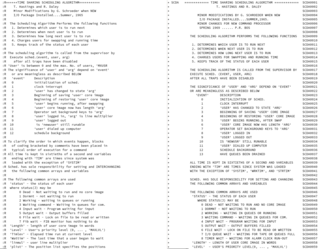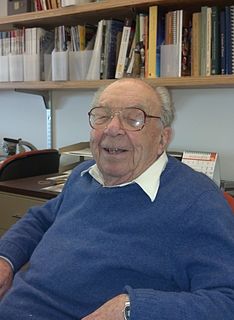Related Research Articles

Multics is an influential early time-sharing operating system based on the concept of a single-level memory. Nathan Gregory writes that Multics "has influenced all modern operating systems since, from microcomputers to mainframes."

In computing, time-sharing is the sharing of a computing resource among many users at the same time by means of multiprogramming and multi-tasking.
MAD is a programming language and compiler for the IBM 704 and later the IBM 709, IBM 7090, IBM 7040, UNIVAC 1107, UNIVAC 1108, Philco 210-211, and eventually the IBM S/370 mainframe computers. Developed in 1959 at the University of Michigan by Bernard Galler, Bruce Arden and Robert M. Graham, MAD is a variant of the ALGOL language. It was widely used to teach programming at colleges and universities during the 1960s and played a minor role in the development of CTSS, Multics, and the Michigan Terminal System computer operating systems.
The GE 645 mainframe computer was a development of the GE 635 for use in the Multics project. This was the first computer that implemented a configurable hardware protected memory system. The original CTSS was implemented on a modified IBM 7094 with two banks of memory and bank-switching between user and supervisor mode, i.e. programs running in the A-core memory bank had access to instructions that programs running in the B-core bank did not. The Multics operating system implemented multilevel security (MLS) on a GE 635 by running a simulator of the 645 starting on October 18, 1965, in the MIT Tech Center. This simulated environment was replaced by the first 645 hardware in 1967. The GECOS operating system was fully replaced by Multics in 1969 with the Multics supervisor separated by protection rings with "gates" allowing access from user mode. A later generation in the form of the 645F wasn't completed by the time the division was sold to Honeywell, and became known as the Honeywell 6180. The original access control mechanism of the GE/Honeywell 645 were found inadequate for high speed trapping of access instructions and the re-implementation in the 6180 solved those problems. The bulk of these computers running time-sharing on Multics were installed at the NSA and similar governmental sites. Their usage was limited by the extreme security measures and had limited impact on subsequent systems, other than the protection ring.
TYPSET is an early document editor that was used with the 1964-released RUNOFF program, one of the earliest text formatting programs to see significant use.

Malcolm Douglas McIlroy is a mathematician, engineer, and programmer. As of 2019 he is an Adjunct Professor of Computer Science at Dartmouth College. McIlroy is best known for having originally proposed Unix pipelines and developed several Unix tools, such as spell, diff, sort, join, graph, speak, and tr. He was also one of the pioneering researchers of macro processors and programming language extensibility. He participated in the design of multiple influential programming languages, particularly PL/I, SNOBOL, ALTRAN, TMG and C++.
General Comprehensive Operating System is a family of operating systems oriented toward the 36-bit GE/Honeywell mainframe computers.
Robert H. Morris Sr. was an American cryptographer and computer scientist.

The Compatible Time-Sharing System (CTSS) was the first general purpose time-sharing operating system. Compatible Time Sharing referred to time sharing which was compatible with batch processing; it could offer both time sharing and batch processing concurrently.

Fernando José "Corby" Corbató was a prominent American computer scientist, notable as a pioneer in the development of time-sharing operating systems.

CP/CMS is a discontinued time-sharing operating system of the late 1960s and early 1970s, known for its excellent performance and advanced features. It had three distinct versions:

Roberto Mario "Robert" Fano was an Italian-American computer scientist and professor of electrical engineering and computer science at the Massachusetts Institute of Technology.

z/VM is the current version in IBM's VM family of virtual machine operating systems. z/VM was first released in October 2000 and remains in active use and development as of 2020. It is directly based on technology and concepts dating back to the 1960s, with IBM's CP/CMS on the IBM System/360-67. z/VM runs on IBM's IBM Z family of computers. It can be used to support large numbers (thousands) of Linux virtual machines.

Louis Pouzin is a French computer scientist. He designed an early packet communications network, CYCLADES.
Request price quotation or RPQ is a long-standing IBM designation for a product or component that is potentially available, but that is not on the "standard" price list. Typical RPQ offerings are custom interfaces, hardware modifications, research or experimental systems, or variable-cost items. In the days of IBM's large mainframes, e.g. the System/360 and System/370 series, many unusual features were flagged as "RPQ".
This article covers the History of CP/CMS — the historical context in which the IBM time-sharing virtual machine operating system was built.
Bernard S. Greenberg is a programmer and computer scientist, known for his work on Multics and the Lisp machine.
Glenda Schroeder is an American software engineer noted for implementing the first command-line user interface shell and publishing one of the earliest research papers describing electronic mail systems while working as a member of the staff at the MIT Computation Center in 1965.
The history of email entails an evolving set of technologies and standards that culminated in the email systems in use today.

Technology Square, nicknamed Tech Square, is a commercial office building complex in the Kendall Square neighborhood of Cambridge, Massachusetts, immediately adjacent to the campus of the Massachusetts Institute of Technology (MIT), which is one of the most prestigious colleges in the world.
References
- The Multics web site, Mirror of multicians.org
- Tom Van Vleck's home page
- Tom Van Vleck, "THVV Multics Bio", Multicians.org, most recent update 11/29/02
- Jeffrey R. Yost, "An Interview with Thomas Van Vleck", 24 October 2012, Computer Security History Project, Charles Babbage Institute
